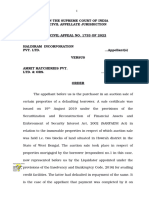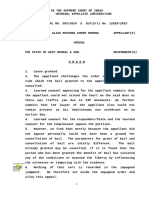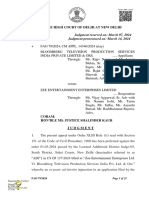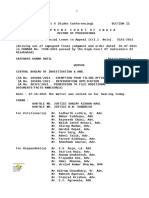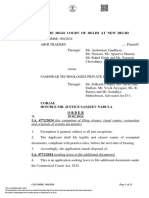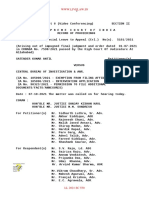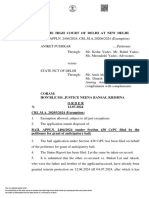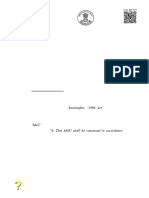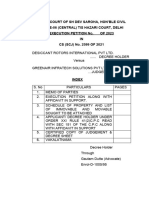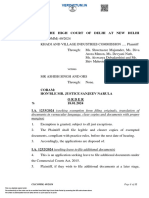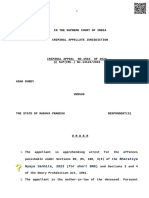Ambuja Cement LTD Vs Collector of Stamps WPC No 5638 of 2014
Uploaded by
shrey23sinhaCopyright:
Available Formats
Ambuja Cement LTD Vs Collector of Stamps WPC No 5638 of 2014
Uploaded by
shrey23sinhaOriginal Title
Copyright
Available Formats
Share this document
Did you find this document useful?
Is this content inappropriate?
Copyright:
Available Formats
Ambuja Cement LTD Vs Collector of Stamps WPC No 5638 of 2014
Uploaded by
shrey23sinhaCopyright:
Available Formats
$~
* IN THE HIGH COURT OF DELHI AT NEW DELHI
% Reserved on: September 26, 2024
Decided on: November 06, 2024
+ W.P.(C) 5638/2014 & CM APPL. 13964/2014
AMBUJA CEMENT LTD. ..... Petitioner
Through: Mr. Sudhanshu Batra,
Senior Advocate with
Mr. Vijay Kumar Singh,
Mr. Adhip Ray,
Mr. Shashwat Singh,
Ms. Simran Sakunia and
Ms. Simran Jeet, Advocates
COLLECTOR OF STAMPS, DELHI ..... Respondent
Through: Mr. Santosh Kumar
Tripathi, Standing Counsel
with Mr. Divyam Nandrajog,
Ms. Surbhi Soni and
Mr. Rishabh Srivastava,
Advocates
CORAM
HON'BLE DR. JUSTICE SUDHIR KUMAR JAIN
JUDGMENT
1. The present petition is filed on behalf of the petitioner under
Articles 226 and 227 of the Constitution for quashing of the
impugned order dated 07.08.2014 bearing reference no.
Signature Not Verified
Digitally Signed
By:HARVINDER KAUR
BHATIA
Signing Date:07.11.2024 W.P.(C) 5638/2014 Page 1
11:34:13
F.10/Misc(Merger)/COS(HQ)/CD/183 (hereinafter referred to as
“the impugned order”) passed by the respondent along with
consequential proceedings and for restraining the respondent from
taking any coercive action against the petitioner. The petitioner has
prayed as under:
a) Issue a writ of certiorari or any other appropriate writ,
order, or direction in the nature thereof, striking down and
quashing the Impugned Order bearing reference No.
F.10/Misc(Merger)/COS(HQ)/CD/183 and dated 07.08.2014
passed by the Respondent in the matter of Show Cause
Notice bearing No. F.10/COS/HQ/CD/Merger/12556 dated
20.03.2014, and any proceedings initiated, or contemplated
to be initiated, by the Respondent pursuant to, or in
furtherance of, the Impugned Order, as against the
Petitioner, its Directors, officials, representatives etc.;
b) Issue a writ of mandamus or any other appropriate writ,
border, or direction in the nature thereof restraining the
Respondent from taking any further coercive action(s) or
initiating any proceedings pursuant to, or in furtherance of,
the Impugned Order against the Petitioner, its Directors,
officials, representatives etc.;
c) Issue any other appropriate writ, order or directions as
the facts and circumstances of the present case may
require; and
d) Grant costs.
2. The factual background of the case is that Holcim (India)
Private Limited (hereinafter referred to as “the petitioner”) is a
Signature Not Verified
Digitally Signed
By:HARVINDER KAUR
BHATIA
Signing Date:07.11.2024 W.P.(C) 5638/2014 Page 2
11:34:13
private limited company incorporated under the Companies Act,
1956 and is a wholly owned subsidiary of Holderind Investments
Ltd., Mauritius (hereinafter referred to as “Holderind”). Ambuja
Cements India Private Limited (hereinafter referred to as “ACIPL”)
was incorporated under the Companies Act was an investment
company and did not undertake any business. ACIPL was a 100%
subsidiary of Holderind which held 55% shares of ACIPL directly
and the remaining 45% shares were held by the petitioner. The
Boards of Directors of the petitioner and ACIPL approved a scheme
of amalgamation between these two companies on 03.04.2009 and
04.09.2009 and ACIPL was proposed to be merged into the
petitioner. Thereafter an application under sections 391 to 394 of the
Companies Act, 1956 was filed for sanction of the scheme of
amalgamation. ACIPL did not have any immovable property at that
time and the only movable property held by ACIPL was its
shareholding in ACC Limited (hereinafter referred to as “ACC”) and
Ambuja Cements Limited (hereinafter referred to as “ACL”) in
dematerialized form. A Coordinate Bench of this Court approved the
merger of ACIPL into the petitioner vide order dated 14.11.2011
Signature Not Verified
Digitally Signed
By:HARVINDER KAUR
BHATIA
Signing Date:07.11.2024 W.P.(C) 5638/2014 Page 3
11:34:13
(hereinafter referred to as “the merger order”). The merger order
was filed with the Registrar of Companies, Delhi and Haryana on
07.02.2011 and the merger came into effect from 06.01.2012. The
petitioner in a meeting held on 30.11.2012 issued 353,84,08,355
equity shares to the shareholders of ACIPL in accordance with the
share exchange ratio and ACIPL was dissolved without winding up.
The Board of Directors also authorized issuance of share certificate
bearing no.12 to Holderind under the common seal of the petitioner
which was issued under the common seal of the petitioner signed by
two Directors and the Company Secretary of the petitioner in
Haryana. The requisite stamp duty as per the Indian Stamp Act, 1899
(hereinafter referred to as “the Act”) as applicable to the State of
Haryana was also affixed to the share certificate at Haryana.
2.1 The petitioner received a show-cause notice dated 20.03.2014
bearing no.F.10/COS/HQ/CD/Merger/12556 (hereinafter referred to
as “the show-cause notice”) on 29.04.2014 issued by the respondent
wherein it was stated that the respondent noticed that the petitioner
has filed a Form 21 dated 07.12.2011 vide SRN no. B-26545426 for
registration of the merger order for giving effect to the amalgamation.
Signature Not Verified
Digitally Signed
By:HARVINDER KAUR
BHATIA
Signing Date:07.11.2024 W.P.(C) 5638/2014 Page 4
11:34:13
It was alleged in the show-cause notice that the petitioner had not
paid the stamp duty on the merger order and was directed to furnish
proof of payment of stamp duty on the conveyance as per the Act,
failing which, non-payment of stamp duty within prescribed time
would be considered as an act of evasion of stamp duty and would
attract heavy penalty and prosecution of Directors and officers in
default. The show-cause notice also specified that it was being issued
in view of the judgment passed by this Court in Delhi Towers Ltd. V
G.N.C.T. of Delhi, 2009 SCC OnLine Del 3959 (hereinafter referred
to as “Delhi Towers Ltd.”). The show-cause notice directed the
Director or Authorized Representative of the petitioner to appear
before the respondent on 27.03.2014 along with supporting
documents. The petitioner submitted a preliminary reply dated
06.05.2014 and detailed reply dated 21.05.2014 wherein it was stated
that no stamp duty was payable on the merger order under the head
‘conveyance’ and the transfer of shares of ACC and ACL from
ACIPL to the petitioner in dematerialized form did not attract any
stamp duty. The respondent issued another notice to the petitioner on
28.05.2014 stating that the petitioner has submitted an application for
Signature Not Verified
Digitally Signed
By:HARVINDER KAUR
BHATIA
Signing Date:07.11.2024 W.P.(C) 5638/2014 Page 5
11:34:13
adjudication of stamp duty on merger and the petitioner was directed
to produce certain documents. The petitioner filed a written response
dated 03.06.2014 wherein it was stated that the petitioner had not
submitted any application to the respondent and was under no
obligation to submit any documents to the respondent. It was also
stated that both the transferor and transferee companies were wholly
owned subsidiaries of a common parent company. The merger had
taken place between two subsidiary companies of each of which not
less than 90 per cent of the share capital was in the beneficial
ownership of a common parent company and the said transaction was
not exigible to stamp duty by virtue of Notification no. 13 dated
25.12.1937 issued by the Central Government (hereinafter referred to
as “the 1937 Notification”) which was also mentioned in the Delhi
Towers Ltd. judgment. The respondent passed the impugned order
on 07.08.2014 holding that as per Article 23 of Schedule IA of the
Act, the petitioner was liable to pay stamp duty on the merger order
@ 3% of the total amount of Rs.7295,93,97,242/- which comes to
Rs.218,87,81,917.26 besides imposing penalty of Rs.69,00,00,000/-
upon the petitioner. The respondent also held that the petitioner was
Signature Not Verified
Digitally Signed
By:HARVINDER KAUR
BHATIA
Signing Date:07.11.2024 W.P.(C) 5638/2014 Page 6
11:34:13
liable to pay stamp duty on the issue of 353,84,08,335 equity shares
pursuant to the merger as per Article 19 of Schedule IA of the Act.
The respondent had not considered the 1937 Notification despite
relying upon Delhi Towers Ltd. and the petitioner submitted
representation dated 22.08.2014 to the respondent to bring the said
omission to its notice.
2.2 The petitioner, being aggrieved filed the present petition and
challenged impugned order on the grounds that the respondent
misinterpreted and misapplied Delhi Towers Ltd. while passing the
impugned order. The respondent did not consider and appreciate that
as per Delhi Towers Ltd., an approved scheme of amalgamation
would amount to transfer inter vivos between two companies only
where right, title and interest in immovable property of the transferor
company was transferred to transferee company and that the present
scheme of amalgamation does not fall under the said category. The
respondent failed to appreciate that for a merger order to be
stampable, the transfer of immovable properties thereunder must be
in presenti to be covered under the definition of ‘conveyance’ as per
section 2(10) of the Act. The respondent erred in treating the merger
Signature Not Verified
Digitally Signed
By:HARVINDER KAUR
BHATIA
Signing Date:07.11.2024 W.P.(C) 5638/2014 Page 7
11:34:13
order as exigible to stamp duty as a conveyance. The respondent did
not appreciate the settled position of law that in order to determine
whether or not an instrument is exigible to stamp duty, it is
mandatory to consider the terms of the said instrument and not
merely the label of the said instrument. A merger order could be
stamped as a conveyance only if it results in transfer of an
asset/property which is not provided elsewhere in Schedule IA of the
Act. The merger order to be chargeable as a conveyance, the merger
order must be covered under Article 23 of Schedule IA of the Act
which does not apply to transfer of shares exempted under Article 62
of Schedule IA of the Act. The transfer of shares of ACC and ACL
held by ACIPL in dematerialized form was not liable to attract stamp
duty as per section 8A of the Act. The impugned order is erroneous
in concluding that the merger order is an instrument of conveyance
chargeable under Article 23 of Schedule IA of the Act.
2.3 The respondent has exceeded his jurisdiction by requiring the
petitioner to produce documents or information which is not provided
for under either section 31 or 33 of the Act. The respondent did not
have jurisdiction to issue notices dated 20.03.2014 and 28.05.2014
Signature Not Verified
Digitally Signed
By:HARVINDER KAUR
BHATIA
Signing Date:07.11.2024 W.P.(C) 5638/2014 Page 8
11:34:13
directing the petitioner to appear before him and produce the
documents. The respondent erred in dismissing the jurisdictional
objections raised by the petitioner by stating that the petitioner is
estopped from raising such objections. The respondent failed to
appreciate that lack of jurisdiction cannot be cured by consent or acts
of the parties. The respondent has exceeded its jurisdiction in seeking
to levy on the petitioner as section 40 of the Act provides for
imposition of penalty only in cases where the respondent exercises
powers under section 33 or section 38(2) of the Act. The impugned
order is reflecting inconsistencies and contradictions. The respondent
did not consider that the 1937 Notification is applicable to the present
case as Holderind held more than 90% of the share capital of ACIPL
and the petitioner which are both 100% subsidiaries of Holderind.
The merger order was clearly covered under the 1937 Notification
and was exempt from payment of stamp duty. The respondent has
erroneously directed the petitioner to pay stamp duty on the issue of
shares pursuant to the amalgamation in accordance with Article 19 of
Schedule IA of the Act. The petitioner raised other grounds and
prayed that the impugned order be quashed along with consequential
Signature Not Verified
Digitally Signed
By:HARVINDER KAUR
BHATIA
Signing Date:07.11.2024 W.P.(C) 5638/2014 Page 9
11:34:13
proceedings and the respondent be restrained from taking any
coercive action against the petitioner.
3. The respondent filed counter affidavit wherein denied
averments made by the petitioner in the petition. The petitioner has
not availed equally efficacious remedy which is available under
section 56 of the Act. The issue involved in the present petition is
chargeability of scheme of de-merger/merger/amalgamation. A
scheme or an order of a court approving a scheme per se is not
exempted from chargeability of stamp duty. A scheme settled inter
vivos between the shareholders of transferor and transferee company
duly approved by the court under sections 391 and 392 of the
Companies Act is an instrument as defined under section 2(14) of the
Act. Every scheme is covered under the definition of instrument and
also a document by which properties are transferred by the transferor
company to the transferee company without the process of liquidation
of the transferor company. This Court in Delhi Towers Ltd. has held
that the order approving the scheme of amalgamation passed by the
company court in exercise of jurisdiction under section 394(2) of the
Companies Act which has the effect of transferring all assets and
Signature Not Verified
Digitally Signed
By:HARVINDER KAUR
BHATIA
Signing Date:07.11.2024 W.P.(C) 5638/2014 Page 10
11:34:13
liabilities including the property of the transferor company to the
transferee company would be exigible to stamp duty under the Act.
The scheme of amalgamation/merger involves transfer of a business
including transfer of assets and liabilities and consideration of which
is the allotment of shares of the transferee company to the
shareholders of the transferor company. The transfer of property
upon sanction of scheme has all the ingredients of sale and that the
orders sanctioning the scheme would be instruments for the purpose
of the Act and would attract stamp duty.
3.1 The petitioner has mixed the issue of chargeability of the order
approving a scheme with the chargeability of shares issued in
pursuance of such scheme. The stamp duty is chargeable on scheme
and not on transfer of shares and the scheme is chargeable to stamp
duty in terms of Article 23 of Schedule IA. The exemption granted
under section 8A of the Act is for securities dealt in a depository and
shares would not qualify as securities and as such the exemption
granted under section 8A is not applicable to shares dealt in a
depository. The scheme where all properties of transferor company
are transferred to the transferee then duty is payable as conveyance
Signature Not Verified
Digitally Signed
By:HARVINDER KAUR
BHATIA
Signing Date:07.11.2024 W.P.(C) 5638/2014 Page 11
11:34:13
under Article 23 of Schedule IA of the Act and share certificates
issued to the shareholders of the transferor company in pursuance of
the scheme shall be exigible to additional stamp duty in terms of
Article 19 of Schedule IA. The petitioner did not take the plea of
exemption granted vide the 1937 Notification during the adjudicatory
process and the conditions pre-requisite for applicability of 1937
Notification are not fulfilled in the present case. The 1937
Notification is no longer applicable as it stood repealed when the
Central Government, vide GSR 1958, extended Schedule IA of the
Stamp Act of Punjab to Delhi.
3.2 Section 47A (3) which was inserted vide the Indian Stamp
(Delhi Second Amendment) Act, 2001 confers suo-motu powers
upon the Collector to determine the chargeable duties and deficient
amount. Section 47A (4) of the Act provides for an appeal before the
District Court and similarly section 56 of the Act provides for
revisional jurisdiction of the Chief Controlling Revenue Authority.
The petitioner has not availed these alternative remedies, hence the
present writ petition is not maintainable. The impugned order is not
arbitrary, unreasonable, illegal, mala fide or erroneous and has not
Signature Not Verified
Digitally Signed
By:HARVINDER KAUR
BHATIA
Signing Date:07.11.2024 W.P.(C) 5638/2014 Page 12
11:34:13
been passed in excess of jurisdiction. The petitioner was granted
sufficient, fair and reasonable opportunities before passing of the
impugned order.
3.3 The petitioner is not a wholly owned subsidiary of Holderind.
ACIPL was not merely an investment company and the petitioner
never made this assertion during the adjudicatory process. The
amalgamation of two companies by which a running business
concern is transferred and merged with the transferee company is
‘conveyance’ and is chargeable to stamp duty under Article 23 of
Schedule IA of the Act. It is not necessary that there should be
transfer of immovable property for a merger order to be chargeable to
stamp duty. There is no occasion to read Article 62 into Article 23 of
Schedule IA as it applies to a separate and independent transaction of
transfer of shares. The merger order which satisfies the definition of
conveyance would be chargeable to stamp duty under Article 23 of
Schedule IA of the Act. Section 8A of the Act applies to securities
dealt in a depository which is not the case of the petitioner.
3.4 The respondent did not carry out any roving enquiry beyond
the powers provided under the Act. There was no occasion for the
Signature Not Verified
Digitally Signed
By:HARVINDER KAUR
BHATIA
Signing Date:07.11.2024 W.P.(C) 5638/2014 Page 13
11:34:13
respondent to carry out any enquiry when the fact of merger by
scheme of amalgamation is not disputed. The information, if any,
sought by the respondent was only to ensure correct chargeability of
stamp duty. The power of the respondent to recover stamp duty is not
controlled by section 31 or 33 of the Act. Section 48 of the Act is an
enabling provision independent of sections 31, 35, 38 or 40 of the
Act and as such, it is not necessary that unless the original instrument
is produced, duty cannot be recovered. The case of the petitioner is
not covered by the 1937 Notification as neither the 1937 Notification
is applicable in case of Schedule IA of the Act, nor the petitioner
satisfies the condition of at least 90% holding of shares of the
subsidiary company by the holding or the parent company. The
petitioner is also liable to pay the stamp duty on the issue of share
certificate. It is stated that the present petition is not maintainable and
liable to be dismissed.
4. The petitioner filed a rejoinder to the counter affidavit filed on
behalf of the respondent wherein the contents of the counter affidavit
were denied and the contents of the writ petition were reiterated. It is
stated that the present case is not filed for evasion and the petitioner
Signature Not Verified
Digitally Signed
By:HARVINDER KAUR
BHATIA
Signing Date:07.11.2024 W.P.(C) 5638/2014 Page 14
11:34:13
has paid the stamp duty exigible on the issuance of Share Certificate
no.12. The respondent has constantly attempted to improve its case
which is impermissible and has attempted to provide supplemental
reasoning for making the merger order exigible to stamp duty on
grounds which were not even considered while passing the impugned
order. The only premise on which the show-cause notice and the
impugned order were issued was the decision in Delhi Towers Ltd.
4.1 The respondent has assumed jurisdiction solely on the basis of
its misplaced reliance on Delhi Towers Ltd. The respondent does not
have power to compel production of documents and can impose
stamp duty only upon original documents produced before it and not
otherwise. The respondent has erroneously distinguished between
‘shares’ and ‘securities’ to exclude the applicability of section 8A of
the Act. The respondent has not only exceeded its jurisdiction in
seeking to levy penalty on the petitioner but also failed to assign
reasons for levying such a heavy penalty. The respondent did not
record reasons before imposing the penalty which shows that the
respondent acted arbitrarily. The impugned order is illegal, arbitrary
and capricious. The alternative remedy is not available to the
Signature Not Verified
Digitally Signed
By:HARVINDER KAUR
BHATIA
Signing Date:07.11.2024 W.P.(C) 5638/2014 Page 15
11:34:13
petitioner as the respondent has acted in excess of jurisdiction. This
Court has jurisdiction under Article 226 of the Constitution to
entertain a writ petition despite availability of alternative statutory
remedies especially where the authority did not have jurisdiction. An
appeal/revision under section 56 of the Act can be filed before the
Chief Controlling Revenue Authority only against an order passed
under Chapter IV or V of the Act and the impugned order in the
present case has not been passed under the said Chapters, hence the
remedy as per section 56 of the Act is not available to the petitioner.
4.2 Section 48 of the Act only empowers the respondent to recover
amounts due under Chapter IV of the Act however, the impugned
order has not been passed under Chapter IV of the Act. The
respondent has erroneously averred that Delhi Towers Ltd. is
applicable to the present case on the ground that every scheme of
amalgamation sanctioned by the Court is an instrument exigible to
stamp duty. This Court in Delhi Towers Ltd. while examining the
issue of exigibility of amalgamation order to stamp duty, considered
several aspects including transfer of movable/immovable properties
and assets/liabilities of the company but in the present case, the
Signature Not Verified
Digitally Signed
By:HARVINDER KAUR
BHATIA
Signing Date:07.11.2024 W.P.(C) 5638/2014 Page 16
11:34:13
transferor company i.e. ACIPL did not hold any property, assets or
employees. Delhi Towers Ltd. is not applicable to the present case
as the transfer of shares does not come under the definition of
conveyance. The respondent has wrongly created a distinction
between shares and securities. The respondent never raised issue of
stamp duty payable on the shares issued in pursuance of the scheme
of amalgamation either in the show-cause notice or at the time of
hearing. The petitioner prayed that the present petition be allowed in
terms of the prayer clause of the petition.
5. Sh. Sudhanshu Batra, the learned Senior Counsel for the
petitioner advanced oral arguments and written submissions are also
filed on behalf of the petitioner. It is argued that the respondent has
acted beyond the powers vested in him as the respondent does not
have power to adjudicate stamp duty except under the provisions of
section 31 (where an instrument is brought to the Collector to seek
his opinion as to the duty chargeable) and section 33 (where an
authorized officer impounds an instrument that comes into his
possession) of the Act. The Act does not empower or authorise the
respondent to adjudicate or levy stamp duty in any other manner. The
Signature Not Verified
Digitally Signed
By:HARVINDER KAUR
BHATIA
Signing Date:07.11.2024 W.P.(C) 5638/2014 Page 17
11:34:13
impugned order is ex facie illegal as it has not been passed under the
abovementioned provisions. The respondent has clearly admitted in
the impugned order as well as its counter affidavit that the power
exercised in the present case was not under sections 31, 35, 38 or 40
of the Act but under section 48 of the Act which is an enabling
provision, however, section 48 merely empowers recovery of all
duties, penalties and other sums required to be paid under Chapter IV
which is not the respondent’s case. Section 31 of the Act does not
empower the respondent to compel production of an instrument,
rather the instrument has to be brought voluntarily before the
respondent and even for exercising power under section 33 of the
Act, a document must have been voluntarily produced. The
respondent has exceeded his jurisdiction by requiring the petitioner to
produce documents or information by way of a roving enquiry. The
learned Senior Counsel placed reliance on District Registrar and
Collector V Canara Bank, (2005) 1 SCC 496; Ashok Kamal
Capital Builders V State and Another, 2009 SCC OnLine Del
2626; Kotak Mahindra Bank Ltd. V Yogesh Baweja and
Signature Not Verified
Digitally Signed
By:HARVINDER KAUR
BHATIA
Signing Date:07.11.2024 W.P.(C) 5638/2014 Page 18
11:34:13
Another, 2013 SCC OnLine Del 2738 and Ajit Singh V Vinod
Kumar and Others, 2014 SCC OnLine Del 192.
5.1 Sh. Batra further argued that section 47A is inapplicable and
reliance on section 47A by the respondent is clearly an after-thought,
misplaced and untenable. He argued that the respondent has
attempted to justify the impugned order as being permissible under
section 47A (3) read with section 73 of the Act, however, section
47A (3) is not applicable to the present case as none of the conditions
precedent exist and section 73 of the Act has no connection with the
issues involved in the present petition. Section 47A (3) pertains only
to documents that can be registered under the Registration Act, 1908
whereas the scheme of amalgamation cannot be registered under the
Registration Act, 1908, hence section 47A is ex facie inapplicable.
The fact of registration of an instrument but omission to refer it to the
Collector for determination of duty is a condition precedent for the
exercise of suo motu power under section 47A (3) of the Act,
therefore, suo motu power can only be exercised in respect of
registered instruments which is not the case in the present matter.
Sh. Batra further argued that even if it is assumed that section 47A is
Signature Not Verified
Digitally Signed
By:HARVINDER KAUR
BHATIA
Signing Date:07.11.2024 W.P.(C) 5638/2014 Page 19
11:34:13
applicable to the present case, the petitioner filed Form 21 with the
Registrar of Companies on 07.12.2011 and as per section 47A (3),
the respondent could have exercised suo motu power within two
years from the date of registration i.e. till 06.12.2013. However, the
show-cause notice was issued on 20.03.2014 which is beyond the
period of limitation provided under section 47A. Section 47A was
enacted to remedy the mischief of undervaluation of immovable
properties and is not applicable to the present case. The learned
Senior Counsel cited V.N. Devadoss V Chief Revenue Control
Officer-cum-Inspector and Others, (2009) 7 SCC 438.
5.2 Sh. Batra primarily and forcefully argued that the scheme of
amalgamation is exempted from payment of any stamp duty in terms
of the 1937 Notification which specifically exempts duty on
instruments transferring property between two subsidiary companies
of each of which not less than 90% of the share capital is in the
beneficial ownership of a common parent company. In the present
case, more than 90% share capital of the petitioner and ACIPL is held
by a common parent company i.e. Holderind. Therefore, the 1937
Notification exempts the scheme of amalgamation from any stamp
Signature Not Verified
Digitally Signed
By:HARVINDER KAUR
BHATIA
Signing Date:07.11.2024 W.P.(C) 5638/2014 Page 20
11:34:13
duty. Sh. Batra in support of his argument cited Delhi Towers Ltd.
wherein it was held that the 1937 Notification is applicable and
binding.
5.3 The respondent in impugned order placed reliance on Delhi
Towers Ltd. Sh. Batra argued reliance on Delhi Towers Ltd. is
misplaced as it is not an authoritative law for imposition of stamp
duty on all types of schemes of amalgamation. He argued that in the
said case, immovable properties were sought to be transferred under a
scheme of amalgamation and it was held that the stamp duty must be
paid at the time of mutation of immovable properties even if such
mutation is pursuant to a scheme of amalgamation. The Delhi
Towers Ltd. case is distinguishable from the present case as there is
no transfer of immovable properties by the scheme of amalgamation
and present case only involves a transfer of shares in dematerialized
form which is specifically provided for in Article 62 (a) of Schedule
IA of the Act. Section 8A of the Act specially exempts the transfer of
shares in dematerialized form from stamp duty. Sh. Batra argued that
it would be against the legislative intent to read Delhi Towers Ltd.
Signature Not Verified
Digitally Signed
By:HARVINDER KAUR
BHATIA
Signing Date:07.11.2024 W.P.(C) 5638/2014 Page 21
11:34:13
to authorise levy of stamp duty on a transfer that is not conveyance
and specifically exempted by the legislature.
5.4 Sh. Batra also advanced arguments on maintainability of the
present petition and stated that the respondent has wrongly
challenged the maintainability of the present petition on the ground
that section 56 of the Act provides an alternative efficacious remedy.
Section 56 does not provide any right of appeal or remedy to the
petitioner. The procedure provided under section 56 is an internal
mechanism empowering the Collector to refer certain cases to his
superior i.e. the Chief Controlling Revenue Authority where there is
an ambiguity regarding the amount of duty chargeable on an
instrument. The Chief Controlling Revenue Authority under section
56 has limited power to intervene only in matters under Chapters IV
and V, clause (a) of first proviso to section 26, sections 31, 40 or 41
of the Act and such limited powers cannot be construed to be powers
of revision or appeal. He further argued that even if it is assumed that
section 56 provides for an appeal or revision before the Chief
Controlling Revenue Authority, the impugned order has not been
passed under Chapter IV or V of the Act and therefore, the said
Signature Not Verified
Digitally Signed
By:HARVINDER KAUR
BHATIA
Signing Date:07.11.2024 W.P.(C) 5638/2014 Page 22
11:34:13
remedy is not available to the petitioner. Sh. Batra stated that it is a
settled position of law that availability of alternative remedy does not
per se bar an aggrieved party from invoking the writ jurisdiction of
this Court. The learned Senior Counsel placed reliance in this regard
on Whirlpool Corporation V Registrar of Trademarks, (1998) 8
SCC 1 and State of Uttar Pradesh V Mohammad Nooh, 1957 SCC
OnLine SC 21.
5.5 Sh. Batra argued that present case is covered under section 8A
of the Act as it stood prior to the amendment made in the year 2019.
The ‘Depository’ is defined under section 2(1)(e) of the Depositories
Act, 1996 which means a company which has been granted a
certificate of registration under section 12(1A) of SEBI Act, 1992
and which holds securities like shares, debentures, bonds,
government securities etc. The depository becomes the registered
owner in respect of the security whereas the person who surrenders
the physical shares is recorded as the beneficial owner. In the present
case, there is only transfer of shares in dematerialized form and the
legislative intent, as expressed in section 8A of the Act, is that such
transfer of dematerialized shares should not be charged with stamp
Signature Not Verified
Digitally Signed
By:HARVINDER KAUR
BHATIA
Signing Date:07.11.2024 W.P.(C) 5638/2014 Page 23
11:34:13
duty. It would be against the legislative intent to authorize the levy of
stamp duty on transfer of dematerialized shares which has been
specifically exempted under section 8A of the Act. Section 8A also
has an overriding effect over other provisions of the Act and over
other enactments, therefore stamp duty cannot be levied on the
merger order. Sh. Batra in light of above arguments prayed that the
present petition be allowed.
6. Sh. Santosh Kumar Tripathi, the Standing Counsel for the
respondent advanced oral arguments and written submissions are also
submitted on behalf of the respondent. It is argued that section 2(14)
of the Act provides an inclusive definition for instrument which
includes every document by which any right or liability is created,
transferred, limited, extended, extinguished or recorded and also
includes an electronic record. Sh. Tripathi stated that a share
certificate either physical or dematerialized certainly creates,
modifies, extinguishes or records a right or liability and therefore is
an instrument chargeable under Article 19 of Schedule IA of the Act.
He argued that a court order sanctioning the scheme of amalgamation
between two companies authorises the transfer and vesting of rights,
Signature Not Verified
Digitally Signed
By:HARVINDER KAUR
BHATIA
Signing Date:07.11.2024 W.P.(C) 5638/2014 Page 24
11:34:13
assets and liabilities of transferor company with the transferee
company and an order under section 394 of the Companies Act
constitutes an instrument and comes under the definition of
conveyance as per section 2(10) of the Act. Sh. Tripathi cited
Hindustan Lever V State of Maharashtra, (2004) 9 SCC 438 and
Delhi Towers Ltd. and also cited decisions given by different High
Courts. He argued that stamp duty is payable under Article 23 of
Schedule IA of the Act. The transaction comes under the purview of
‘conveyance’ under the Act, therefore the benefit of any notification
pertaining to ‘transfer of shares’ cannot accrue, as such, the benefit of
the 1937 Notification cannot be given to the petitioner.
6.1 Sh. Tripathi stated that remission in stamp duty was extended
in respect of instrument evidencing transfer of property between
principal and subsidiary company or between the two subsidiary
companies etc. where holding is 90% or above. It was further stated
that the 1937 Notification stood repealed when the Central
Government vide GSR 1958 extended Schedule IA of the Stamp Act
of Punjab to the Union Territory of Delhi. Section 3 of the Act
provides that stamp duty shall be payable as per Schedule I subject to
Signature Not Verified
Digitally Signed
By:HARVINDER KAUR
BHATIA
Signing Date:07.11.2024 W.P.(C) 5638/2014 Page 25
11:34:13
the exemptions contained therein and since Schedule IA was
extended to Delhi, the stamp duty in Delhi is payable only as per
Schedule IA which does not contain any Article remitting the stamp
duty in terms of the 1937 Notification. Schedule IA was
comprehensively amended by the Delhi Assembly in 2001 therefore,
the 1937 Notification is not applicable.
6.2 Sh. Tripathi also referred that the petitioner has contended that
orders under section 394 of the Companies Act have not been
specifically included within the definition of ‘conveyance’ by the
Delhi Assembly. However this Court in Delhi Towers Ltd. has held
that the amendments made to the Stamp legislations in other states
were only clarificatory in nature and absence of similar state
amendment for Delhi does not exempt orders under section 394 of
the Companies Act from stamp duty. He argued that lack of
comparable state amendment for Delhi does not preclude imposition
of stamp duty on orders of the court sanctioning scheme of
amalgamation under section 394 of the Companies Act, 1956.
6.3 Sh. Tripathi also argued that the scheme of amalgamation
transferred a going business concern, therefore Article 23
Signature Not Verified
Digitally Signed
By:HARVINDER KAUR
BHATIA
Signing Date:07.11.2024 W.P.(C) 5638/2014 Page 26
11:34:13
(conveyance) is applicable and not Article 62 (transfer of shares).
The scheme of amalgamation results in destruction of the corporate
identity of ACIPL, thus the transaction far exceeds a mere transfer of
shares. The Supreme Court in Hindustan Lever (supra) and
Hanuman Vitamin Foods (P) Ltd. V State of Maharashtra,
(2006) 6 SCC 345 observed that transfer of immovable property is
not a sine qua non for a transaction to qualify as ‘conveyance’.
Sh. Tripathi placed reliance on section 6 of the Act which provides
that where an instrument comes within two or more descriptions of
Schedule IA chargeable with different duties, it shall be charged with
the highest duty. The petitioner is attempting to defeat the express
provisions of the Act and the Supreme Court in McDowell & Co. V
CTO, (1985) 3 SCC 230 held that it is incumbent upon the judiciary
to combat tax evasion.
6.4 Sh. Tripathi also addressed argument on powers of Collector of
Stamp to compel production and impose duty. He referred section 73
of the Act which provides that every document in custody of a public
officer shall be open to inspection upon authorization by the
Collector to inquire into potential omission of paying stamp duty.
Signature Not Verified
Digitally Signed
By:HARVINDER KAUR
BHATIA
Signing Date:07.11.2024 W.P.(C) 5638/2014 Page 27
11:34:13
The Supreme Court in District Registrar and Collector V Canara
Bank (supra) has interpreted section 73 to empower the Collector to
inspect public record of private documents available in his office.
The merger order in the present case was publically accessible on the
website of Ministry of Corporate Affairs, hence the respondent was
authorized to inspect the merger order as per section 73. The
respondent also has the power to call for and examine any instrument
to satisfy himself as to the correctness of its value or consideration
and determine the duty payable thereon. Sh. Tripathi further argued
that the Collector of Stamp has sufficient power under section 47A(3)
read with section 47A(2) to call for and examine any instrument to
satisfy himself as to correctness of its value or consideration and
determine the duty payable thereon including deficiency which the
person shall be liable to pay. He further referred explanation to
section 47A of the Act provides that the value of any property shall
be estimated to be the price which such property may have fetched, if
sold in the open market on the date of execution of the instrument
relating to transfer of such property. The directions issued by the
respondent to produce the document are necessary and incidental
Signature Not Verified
Digitally Signed
By:HARVINDER KAUR
BHATIA
Signing Date:07.11.2024 W.P.(C) 5638/2014 Page 28
11:34:13
steps in the exercise of his statutory powers and it is settled law that
the power to do a thing also carries the power to regulate the manner
in which it may be done as held by the Supreme Court in State of
Uttar Pradesh V Batuk Deo Tripathi, (1978) 2 SCC 102. The
petitioner has not availed the statutory remedy of appeal before the
District Court provided under section 47A (4) of the Act and cannot
be allowed to invoke the extraordinary writ jurisdiction of this Court.
6.5 Sh. Tripathi also addressed issue i.e. value at which stamp duty
is to be imposed. He argued that the shares of the transferee company
were issued to the shareholders of the transferor company as
consideration for the amalgamation therefore, the price of the said
shares shall be the basis for calculation of stamp duty. The individual
assets and liabilities need not be separately accounted for in arriving
at the said calculation as held by the Supreme Court in Li Taka
Pharmaceuticals Ltd. V State of Maharashtra, 1996 SCC OnLine
Bom 67 which was relied upon by this Court in Delhi Towers Ltd.
Sh. Tripathi placed reliance on section 21 of the Act which provides
that stock and marketable securities shall be valued according to the
average price or value on the date of the instrument. He stated that
Signature Not Verified
Digitally Signed
By:HARVINDER KAUR
BHATIA
Signing Date:07.11.2024 W.P.(C) 5638/2014 Page 29
11:34:13
the consideration paid by the petitioner was valued at
Rs.7295,93,97,242/- therefore, stamp duty @ 3% (as per Article 23
of Schedule IA) was levied amounting to Rs.218,87,81,917.26/-
and a penalty of Rs.69,00,00,000/- was also imposed for
non-payment of stamp duty for more than two years.
7. Sh. Tripathi has challenged the maintainability of the present
petition by arguing that the petitioner has invoked the extraordinary
jurisdiction of this Court without availing the equally efficacious
alternative remedy available under sections 56 or 47A (4) of the Act.
The learned Senior Counsel for the petitioner countered the said
argument by stating that sections 56 and 47A (4) of the Act do not
provide any efficacious alternative remedy to the petitioner and
availability of alternative remedy does not bar the aggrieved party
from invoking the writ jurisdiction of this Court.
7.1 The Supreme Court in Whirlpool Corporation V Registrar
of Trade Marks, (1998) 8 SCC 1, as also referred by the Sh. Batra,
the learned Senior Counsel for the petitioner, observed as under:
14. The power to issue prerogative writs under Article 226
of the Constitution is plenary in nature and is not limited
by any other provision of the Constitution. This power can
be exercised by the High Court not only for issuing writs in
Signature Not Verified
Digitally Signed
By:HARVINDER KAUR
BHATIA
Signing Date:07.11.2024 W.P.(C) 5638/2014 Page 30
11:34:13
the nature of habeas corpus, mandamus, prohibition, quo
warranto and certiorari for the enforcement of any of the
Fundamental Rights contained in Part III of the
Constitution but also for “any other purpose”.
15. Under Article 226 of the Constitution, the High Court,
having regard to the facts of the case, has a discretion to
entertain or not to entertain a writ petition. But the High
Court has imposed upon itself certain restrictions one of
which is that if an effective and efficacious remedy is
available, the High Court would not normally exercise its
jurisdiction. But the alternative remedy has been
consistently held by this Court not to operate as a bar in at
least three contingencies, namely, where the writ petition
has been filed for the enforcement of any of the
Fundamental Rights or where there has been a violation of
the principle of natural justice or where the order or
proceedings are wholly without jurisdiction or the vires of
an Act is challenged. There is a plethora of case-law on this
point but to cut down this circle of forensic whirlpool, we
would rely on some old decisions of the evolutionary era of
the constitutional law as they still hold the field.
xxx xxx xxx
17. A specific and clear rule was laid down in State of U.P.
v. Mohd. Nooh [AIR 1958 SC 86 : 1958 SCR 595] as under:
“But this rule requiring the exhaustion of statutory
remedies before the writ will be granted is a rule of
policy, convenience and discretion rather than a rule of
law and instances are numerous where a writ of
certiorari has been issued in spite of the fact that the
aggrieved party had other adequate legal remedies.”
xxx xxx xxx
20. Much water has since flown under the bridge, but there
has been no corrosive effect on these decisions which,
though old, continue to hold the field with the result that
law as to the jurisdiction of the High Court in entertaining
a writ petition under Article 226 of the Constitution, in
Signature Not Verified
Digitally Signed
By:HARVINDER KAUR
BHATIA
Signing Date:07.11.2024 W.P.(C) 5638/2014 Page 31
11:34:13
spite of the alternative statutory remedies, is not affected,
specially in a case where the authority against whom the
writ is filed is shown to have had no jurisdiction or had
purported to usurp jurisdiction without any legal
foundation.
7.2 It is a well-accepted proposition of law that the power of High
Court to entertain a writ petition under Article 226 of the Constitution
is not barred by the availability of an alternative efficacious remedy.
The argument as advanced by Sh. Tripathi, Standing Counsel for the
respondent does not have legal force and is therefore, rejected.
8. The learned Senior Counsel for the petitioner argued that the
respondent is not having jurisdiction to adjudicate stamp duty except
under sections 31 and 33 and the impugned order is illegal as it has
not been passed under the said provisions. Sections 31 and 33 of the
Act do not empower the respondent to compel production of a
document rather the instrument has to be brought voluntarily before
the respondent. The respondent has clearly admitted that the
respondent has passed the impugned order in exercise of power
conferred upon the respondent by section 48 of the Act, however
section 48 merely empowers the respondent to recover all duties,
penalties and other sums required to be paid under Chapter IV of the
Signature Not Verified
Digitally Signed
By:HARVINDER KAUR
BHATIA
Signing Date:07.11.2024 W.P.(C) 5638/2014 Page 32
11:34:13
Act which is not the case in the present matter. The learned Senior
Counsel for the petitioner in support of his arguments cited District
Registrar and Collector V Canara Bank, (2005) 1 SCC 496
wherein it was held as under:
12. The provisions of Section 29 providing for the persons
by whom duties are payable have been left untouched. So is
with Section 31 dealing with “adjudication as to proper
stamp” which confers power on the Collector to adjudicate
upon the duty with which a document shall be chargeable,
though such document may or may not have been executed.
The scheme of Section 31 involves an element of
voluntariness. The person seeking adjudication must have
brought the document to the Collector and also applied for
such adjudication. The document cannot be compelled to be
brought before him by the Collector. Section 33 confers
power of impounding a document not duly stamped subject
to the document being produced before an authority
competent to receive evidence or a person in charge of a
public office. It is necessary that the document must have
been produced or come before such authority or person in
charge in performance of its functions. The document
should have been voluntarily produced. At the same time,
Section 36 imposes an embargo on the power to impound
vesting in the authority competent to receive evidence, by
providing that it cannot question the admission of
document in evidence once it has been admitted. None of
these provisions have been amended by the State of Andhra
Pradesh.
xxx xxx xxx
58. An instrument which is not duly stamped cannot be
received in evidence by any person who has authority to
receive evidence and it cannot be acted upon by that person
or by any public officer. This is the penalty which is
imposed by law on the person who may seek to claim any
Signature Not Verified
Digitally Signed
By:HARVINDER KAUR
BHATIA
Signing Date:07.11.2024 W.P.(C) 5638/2014 Page 33
11:34:13
benefit under an instrument if it is not duly stamped. Once
detected, the authority competent to impound the
document can recover not only duty but also penalty, which
provision protects the interest of revenue. In the event of
there being criminal intention or fraud, the persons
responsible may be liable to be prosecuted. The availability
of these provisions, in our opinion, adequately protects the
interest of revenue. Unbridled power available to be
exercised by any person whom the Collector may think
proper to authorise, without laying down any guidelines as
to the persons who may be authorised and without
recording the availability of grounds which would give rise
to the belief, on the existence whereof only, the power may
be exercised, deprives the provision of the quality of
reasonableness. Possessing a document not duly stamped is
not by itself any offence. Under the garb of the power
conferred by Section 73 the person authorised may go on a
rampage searching house after house i.e. residences of the
persons or the places used for the custody of documents.
The possibility of any wild exercise of such power may be
remote, but then on the framing of Section 73, the provision
impugned herein, the possibility cannot be ruled out. Any
number of documents may be inspected, may be seized and
may be removed and at the end the whole exercise may
turn out to be an exercise in futility. The exercise may
prove to be absolutely disproportionate to the purpose
sought to be achieved and, therefore, a reasonable nexus
between stringency of the provision and the purpose sought
to be achieved ceases to exist.
8.1 This Court in Ashok Kamal Capital Builders V Canara
Bank, (2005) 1 SCC 496, as also referred by the learned Senior
Counsel for the petitioner, held as under:
23. However, in the National Capital Territory of Delhi no
such power vests with the authorities to compel production
Signature Not Verified
Digitally Signed
By:HARVINDER KAUR
BHATIA
Signing Date:07.11.2024 W.P.(C) 5638/2014 Page 34
11:34:13
of an original document from a party to impound the same
or levy penalty or for direction to pay proper stamp
duty/penalty on failure to produce the original. In several
amendments, limitation period has been prescribed when
an order for production of the original document or for
imposition of penalty on basis of the copy can be passed.
xxx xxx xxx
28. In the light of the aforesaid judgments it is clear that the
Sub-Divisional Magistrate who was also the Collector of
Stamps could not have directed production of the original
agreement dated 23rd December, 1987 or impounded the
photocopy and passed an order directing the petitioners to
pay the deficient stamp duty and penalty. Photocopy of the
agreement dated 23rd December, 1987 is not an
instrument, as defined in Section 2(14) of the Act. The
impugned Order dated 29th November, 2004 therefore
cannot be sustained to the extent that it impounds the
photocopy of the agreement dated 23rd December, 1987
and directs payment of deficient stamp duty and imposes
penalty under Sections 33 and 35 of the Act. It may be
appropriate to refer to the decision of three Judges' Bench
of the Delhi High Court in Dayal Singh v. Collector of
Stamps, AIR 1972 Del. 131, wherein it was observed:
“10. Section 2(6) of the Stamp Act defines „chargeable‟
to mean „chargeable under this Act‟. Section 2(11) of
the Stamp Act defines „duly stamped‟ to mean „that
such stamp has been affixed or used in accordance with
the law for the time being in force in India‟. Under
Section 33 it is only when an instrument is „chargeable
with duty‟ and it „not duly stamped‟ that it can be
impounded. Can the sale deed in question be
impounded under Section 33 because the transfer duty
is either not paid or is insufficiently paid? The answer
must be „No‟. For, the meaning of the expression „any
instrument chargeable‟ or the expression „instrument
not duly stamped‟ used in Section 33 of the Stamp Act
is to be understood in the light of the definitions in
Sections 2(6) and 2(11). „Chargeable‟ means chargeable
Signature Not Verified
Digitally Signed
By:HARVINDER KAUR
BHATIA
Signing Date:07.11.2024 W.P.(C) 5638/2014 Page 35
11:34:13
under the Stamp Act only and not under any other Act.
The Stamp Act authorizes the levy of stamp duty only
and not of the duty on transfer of property. The latter is
authorized by the Corporation Act alone. The sale deed
in question is not, therefore, „chargeable‟ to transfer
duty under the Stamp Act at all. It is not, therefore, an
instrument chargeable to duty within the meaning of
Section 33 of the Stamp Act.”
8.2 Sh. Tripathi, the Standing Counsel for the respondent to
counter the said argument argued that section 47A (3) of the Act
confers suo motu power upon the respondent to determine the duty
chargeable and the deficient amount of duty. Section 73 of the Act
empowers the respondent to inspect public record of private
documents available in his office and the merger order in the present
case was publically accessible on the website of Ministry of
Corporate Affairs, hence the respondent was authorized to inspect the
merger order as per section 73. Sh. Batra in response to this
argument, argued that section 47A of the Act pertains only to
instruments which are capable of being registered under the
Registration Act, 1908 and therefore the said provision is not
applicable to the present case and even if section 47A of the Act is
assumed to be applicable, the exercise of suo motu power under
section 47A(3) by the respondent by issuing the show-cause notice
Signature Not Verified
Digitally Signed
By:HARVINDER KAUR
BHATIA
Signing Date:07.11.2024 W.P.(C) 5638/2014 Page 36
11:34:13
dated 20.03.2014 is barred by limitation. Section 73 of the Act does
not pertain to the issues involved in the present petition and this
ground has been taken by the respondent for the first time in the
written submissions which clearly shows that it is an afterthought.
8.3 Section 47A (3) of the Act, as applicable to Delhi, reads as
under:
(3) The Collector may, suo moto, within two years from the
date of the registration of any instrument not already
referred to him under sub-section (1), call for and examine
the instrument for the purpose of satisfying himself as to
the correctness of its value or consideration, as the case
may be, and the duty payable thereon, and if after such
examination, he has reason to believe that the value or
consideration has not been truly set forth in the instrument,
he may determine the value or consideration and the duty
aforesaid in accordance with the procedure provided under
sub- section (2), and the deficient amount of duty, if any,
shall be payable by the person liable to pay the duty and, on
the payment of such duty, the Collector shall endorse a
certificate of such payment on the instrument under his seal
and signature.
8.4 The meaningful reading of section 47A reflects that it pertains
to instruments which can be registered under the Registration Act,
1908. Section 47A (3) confers suo-motu power on the respondent to
call for and examine any instrument to satisfy himself as to the
correctness of its value or consideration and the duty payable thereon.
Signature Not Verified
Digitally Signed
By:HARVINDER KAUR
BHATIA
Signing Date:07.11.2024 W.P.(C) 5638/2014 Page 37
11:34:13
However, such suo-motu power can only be exercised within two
years from the date of registration of the instrument. In the present
case, the petitioner filed Form 21 with the Registrar of Companies for
registration of the merger order on 07.12.2011 and the respondent
issued the show-cause notice on 20.03.2014 which is beyond the
period of limitation of two years as provided under section 47A (3).
There is legal force in the argument advanced by the learned Senior
Counsel for the petitioner that the exercise of power conferred upon
the respondent by section 47A (3) is appearing to be barred by
limitation.
9. Sh. Tripathi, the Standing Counsel for the respondent argued
that as per section 3 of the Act, an ‘instrument’ is the subject matter
of the charging provision and as per section 2(14), an inclusive
definition has been provided for ‘instrument’ which includes every
document by which any right or liability is, or purported to be,
created, transferred, limited, extended, extinguished or recorded. He
further argued that a share certificate whether in physical or
dematerialized form, certainly creates, modifies, extinguish or
records a right or liability. He further argued that any share certificate
Signature Not Verified
Digitally Signed
By:HARVINDER KAUR
BHATIA
Signing Date:07.11.2024 W.P.(C) 5638/2014 Page 38
11:34:13
irrespective of its physical or dematerialized form is an ‘instrument’
and therefore chargeable with duty under the relevant entries of the
Act. Sh. Tripathi also referred definition of ‘conveyance’ as per
section 2(10) of the Act and argued that this is an inclusive definition
that ‘includes’ a conveyance on sale and every instrument by which
property, whether moveable or immoveable, is transferred inter vivos
and which is not otherwise specifically provided for by Schedule I.
Sh. Tripathi in background of these definitions argued that an order
under section 394 of the Companies Act comes within the definition
of ‘conveyance’ under section 2(10) of the Act. Sh. Tripathi after
referring Hindustan Lever V State of Maharashtra, (2004) 9
SCC 438, argued that a scheme of amalgamation is an agreement
between the parties, wherein the whole or any part of the
undertaking, properties or liability of any company concerned in the
scheme is to be transferred to the other company and the transferor
has all the trappings of a sale. Sh. Tripathi further argued that an
order under section 394 constitutes a document which is captive to
the definition of an ‘instrument’ and in turn, ‘conveyance’ under the
Act. Sh. Tripathi further referred Delhi Towers Ltd. He laid
Signature Not Verified
Digitally Signed
By:HARVINDER KAUR
BHATIA
Signing Date:07.11.2024 W.P.(C) 5638/2014 Page 39
11:34:13
emphasis that stamp duty is payable under Entry 23 of Schedule 1A
of the Act. Sh. Tripathi emphatically argued that benefit of any
notification for ‘transfer of shares’ cannot accrue to the petitioner.
9.1 To appreciate arguments as advanced by Sh. Tripathi, it is
necessary to examine decision delivered by this court in Delhi
Towers Ltd. The factual background of the case, as appearing from
the judgment, is that fifteen companies incorporated under the
provisions of the Companies Act, engaged in the business of real
estate, were proposed to be merged with the Delhi Towers Ltd. which
was also incorporated under the Companies Act. The transferor
companies were stated to be 100% subsidiaries of Delhi Towers Ltd.,
the transferee company. The proposed scheme of amalgamation was
approved by the court after recording statutory compliance.
Thereafter, an application was made to the Tehsildar having
jurisdiction over the properties of the company for effecting mutation
in favour of the transferee company which was not effected as the
stamping authorities have not accepted the scheme of amalgamation
without payment of stamp duty. The issue for consideration was that
whether an order passed by the company court under section 394 of
Signature Not Verified
Digitally Signed
By:HARVINDER KAUR
BHATIA
Signing Date:07.11.2024 W.P.(C) 5638/2014 Page 40
11:34:13
the Companies Act approving a scheme of amalgamation is covered
under definition of ‘conveyance’ as per section 2(10) of the Act and
therefore exigible to stamp duty. It was argued before the court that
by virtue of the order sanctioning the scheme for amalgamation,
nothing further is required to be done for the property to stand
transferred to and vest in the transferee company.
9.2 A Coordinate Bench of this Court in Delhi Towers Ltd.
observed that the Supreme Court in Hindustan Lever V State of
Maharashtra, (2004) 9 SCC 438 held that orders passed by courts
have been subjected to levy of stamp duty in several situations. It was
also observed that the thing which is liable to stamp duty is the
instrument and it is not a transaction of purchase and sale which is
struck at. The Court also observed that merely because the
legislature has not amended the existing statutory provision as
applicable to Delhi to specifically include transfer of property under
an order approving a scheme of amalgamation in the definition of
conveyance, it is of no consequence at all. The same does not amount
to exclusion from applicability of the Indian Stamp Act and
chargeability to stamp duty thereon. It was also observed that the
Signature Not Verified
Digitally Signed
By:HARVINDER KAUR
BHATIA
Signing Date:07.11.2024 W.P.(C) 5638/2014 Page 41
11:34:13
statutory definition of ‘conveyance’ under section 2(10) of the Act is
an inclusive definition of wide import which cannot be confined to
specific instruments mentioned in the statute. It was also observed
that it would be immaterial for purposes of imposition of stamp duty
as to whether the conveyance was by operation of law, statutory
operation or by virtue of a private contract between the parties.
Exemption has to be by specific statutory provisions. It was finally
held as under:-
120. Accordingly, it is held that an approved scheme of
amalgamation amounts to a transfer inter vivos between
two companies who are juristic persons in existence at the
time of passing of the order and sanctioning of the scheme
whereby the right, title and interest in the immoveable
property of the transferor company are transferred to the
transferee company. The transfer takes place in the present
and is not postponed to any later date and is covered under
the definition of conveyance under sub-section 10 of section
2 of the Stamp Act.
9.3 Sh. Batra, the learned Senior Counsel for the petitioner tried to
differentiate between Delhi Towers Ltd. and present case by arguing
that in present case, only moveable property i.e. shares were
transferred. However, there is no convincing decision of any court
that there is a difference between immoveable and moveable
properties for purpose of imposition of stamp duty in case of
Signature Not Verified
Digitally Signed
By:HARVINDER KAUR
BHATIA
Signing Date:07.11.2024 W.P.(C) 5638/2014 Page 42
11:34:13
amalgamation. The argument so advanced by Sh. Batra is without
any legal basis.
9.4 The Court in Delhi Towers Ltd. referred Li Taka
Pharmaceuticals Ltd. V State of Maharashtra, 1996 SCC OnLine
Bom 67 wherein it was held that document of transfer of shares was a
conveyance of property chargeable with stamp duty on basis of
market value of the property. It is clear that the stamp duty is
chargeable on market value of the property. It is apparent that an
order of amalgamation passed under section 394 of the Companies
Act, 1956 is an instrument within the mandate of section 2(10) of the
Act and is chargeable to stamp duty. There is substance in arguments
as detailed hereinabove advanced by Sh. Santosh Tripathi, the
learned Standing Counsel for the respondent.
10. Sh. Batra, the learned Senior Counsel for the petitioner laid
much emphasis and referred the 1937 Notification and argued that
merger order is covered under the said notification and exempted
from stamp duty. It is reflecting that both ACIPL (transferor
company) and the petitioner (transferee company) are wholly owned
subsidiary companies of a common parent company i.e. Holderind
Signature Not Verified
Digitally Signed
By:HARVINDER KAUR
BHATIA
Signing Date:07.11.2024 W.P.(C) 5638/2014 Page 43
11:34:13
and the merger/amalgamation had taken place between two
subsidiary companies of each of which not less than 90% of the share
capital was in the beneficial ownership of a common parent company
i.e. Holderind.
10.1 It is necessary to refer to the relevant portion of the
Notification no. 13 dated 25.12.1937 issued by the Central
Government, which is reproduced as under:
In exercise of the powers conferred by clause (a) of section
9 of the Indian Stamp Act, 1899 (II of 1899), and in
supersession of all previous notifications issued from time
to time under the said clause of the said section in so far as
they relate to the Province of Delhi (hereinafter referred to
as the said Province) except the notification of the
Government of India in the Finance Department (Central
Revenue) No.6 - Stamps, dated the 14th August, 1937, the
Central Government is pleased to reduce, to the extent set
forth in each case, the duties chargeable in the said
Province under the said Act in respect of the instruments
hereinafter described under Nos. 4, 15, 30, 39,40 [43,49, 56
and 57] and to remit the duties so chargeable in respect of
instruments of the other classes hereinafter described:-
xxx xxx xxx
K. OTHER DOCUMENTS
xxx xxx xxx
55. Instrument evidencing transfer of property between
companies limited by shares as defined in the Indian
Companies Act, 1913, in a case where:
Signature Not Verified
Digitally Signed
By:HARVINDER KAUR
BHATIA
Signing Date:07.11.2024 W.P.(C) 5638/2014 Page 44
11:34:13
(i) at least 90 per cent of the issued share capital of the
transferee company is in the beneficial ownership of
the transferor company, or
(ii) where the transfer takes place between a parent
company and a subsidiary company one of which is the
beneficial owner of not less than 90 per cent of the
issued share capital of the other, or
(iii) where the transfer takes place between two subsidiary
companies of each of which not less than 90 per cent of
the share capital is in the beneficial ownership of a
common parent company:
Provided that a certificate is obtained by the parties to the
instrument from the officer appointed in this behalf by the
Chief Commissioner of Delhi that the conditions above
prescribed are fulfilled.
10.2 The Standing Counsel for the respondent countered this
argument by stating that the 1937 Notification dated 25.12.1937 is
not applicable as it stood repealed when the Central Government,
vide GSR 1958, extended Schedule IA of the Stamp Act of Punjab to
the Union Territory of Delhi. Section 3 of the Act provides that stamp
duty shall be payable as per Schedule I subject to the exemptions
contained therein and since Schedule IA was made applicable to
Delhi, the stamp duty has to be paid only as per Schedule IA which
does not contain any Article remitting the stamp duty in terms of the
1937 Notification. Sh. Tripathi argued that the merger order is not
exempted from stamp duty. In response, the learned Senior Counsel
Signature Not Verified
Digitally Signed
By:HARVINDER KAUR
BHATIA
Signing Date:07.11.2024 W.P.(C) 5638/2014 Page 45
11:34:13
for the petitioner argued that this Court in Delhi Towers Ltd. has
held that the 1937 Notification dated 25.12.1937 is applicable and
binding.
10.3 A Coordinate Bench of this Court in Delhi Towers Ltd.
considered applicability and enforceability of the Notification no. 13
dated 25.12.1937 issued by the Central Government. The Court
referred Sandy Estates Ltd. V Landbase India Ltd., (1997) 6 AD
981 (Delhi) wherein the question was whether stamp duty is leviable
on a transfer of assets by a scheme of amalgamation proposed
between a hundred percent owned subsidiary company with its parent
company. Reliance was placed on Notification dated 16th January
1937. It was held in said case that no stamp duty would be leviable in
any case to the transfer of assets between the transferor and transferee
companies when the transferor company is a 100 per cent subsidiary
of the transferee company which is the parent company. This Court
in Delhi Towers Ltd. observed that the Notification no. 13 dated
25.12.1937 issued by the Central Government is applicable and
binding.
Signature Not Verified
Digitally Signed
By:HARVINDER KAUR
BHATIA
Signing Date:07.11.2024 W.P.(C) 5638/2014 Page 46
11:34:13
10.4 Accordingly, the argument advanced by the Standing Counsel
for the respondent that the Notification no. 13 dated 25.12.1937 has
been repealed and is not applicable, does not have any legal force and
is accordingly rejected. The petitioner and ACIPL were wholly
owned subsidiaries of a common parent company – Holderind and
therefore, the scheme of amalgamation and the merger order are
squarely covered under the Notification no. 13 dated 25.12.1937
which exempts the said instruments from payment of stamp duty.
11. The present petition is allowed in view of above discussion.
Accordingly the show-cause notice dated 20.03.2014 and the
impugned order dated 07.08.2014 issued by the respondent are
quashed and set aside along with all consequential proceedings.
12. The present petition stands disposed of along with pending
application.
DR. SUDHIR KUMAR JAIN
(JUDGE)
NOVEMBER 06, 2024
AM
Signature Not Verified
Digitally Signed
By:HARVINDER KAUR
BHATIA
Signing Date:07.11.2024 W.P.(C) 5638/2014 Page 47
11:34:13
You might also like
- Varrsana Ispat v. TCIL (Delhi High Court)No ratings yetVarrsana Ispat v. TCIL (Delhi High Court)5 pages
- BPT Infra Project PVT LTD Vs Indraprastha Ice and Cold Storage PVT LTD 549606No ratings yetBPT Infra Project PVT LTD Vs Indraprastha Ice and Cold Storage PVT LTD 54960612 pages
- Cannot Be Deprived Of Right To Travel Abroad Delhi HC Dismisses Plea Challenging Suspension Of Look Out Circular Against Erstwhile Director Of Wave MegacityNo ratings yetCannot Be Deprived Of Right To Travel Abroad Delhi HC Dismisses Plea Challenging Suspension Of Look Out Circular Against Erstwhile Director Of Wave Megacity8 pages
- SEBI v. R. T. Agro Private Limited & Ors.No ratings yetSEBI v. R. T. Agro Private Limited & Ors.3 pages
- Ratio-Cooperating With Investigation Doesn't Mean Accused Is Expected To Make Self-Incriminating StatementsNo ratings yetRatio-Cooperating With Investigation Doesn't Mean Accused Is Expected To Make Self-Incriminating Statements4 pages
- Delhi High Court-3rd Party Funding JudgmentNo ratings yetDelhi High Court-3rd Party Funding Judgment30 pages
- Arbitration Cal HC 140223 McLeod Vs ABFLNo ratings yetArbitration Cal HC 140223 McLeod Vs ABFL32 pages
- In The High Court of Delhi at New DelhiNo ratings yetIn The High Court of Delhi at New Delhi12 pages
- Ramadhar Sahu Vs The State of Madhya PradeshNo ratings yetRamadhar Sahu Vs The State of Madhya Pradesh4 pages
- 6041 2022 6 301 48908 Order 06-Dec-2023No ratings yet6041 2022 6 301 48908 Order 06-Dec-202310 pages
- HC DEL 2024 Non Advocates barred From Appearing Before Consumer CourtsNo ratings yetHC DEL 2024 Non Advocates barred From Appearing Before Consumer Courts4 pages
- MCRC_3526_2025_FinalOrder_24-01-2025_digiNo ratings yetMCRC_3526_2025_FinalOrder_24-01-2025_digi3 pages
- Prince Vs State of Govt of NCT of Delhi & Ors.No ratings yetPrince Vs State of Govt of NCT of Delhi & Ors.4 pages
- Sequoia Capital Operations LLC V John Doe and OthersNo ratings yetSequoia Capital Operations LLC V John Doe and Others12 pages
- MCRC_3505_2025_FinalOrder_24-01-2025_digiNo ratings yetMCRC_3505_2025_FinalOrder_24-01-2025_digi3 pages
- Abhi Traders VS Fashnear Technologies Private Limited & OrsNo ratings yetAbhi Traders VS Fashnear Technologies Private Limited & Ors13 pages
- Satender Kumar Antil Vs Cbi LL 2021 SC 550 402081No ratings yetSatender Kumar Antil Vs Cbi LL 2021 SC 550 4020816 pages
- Arbitral Award Needs To Be Served To The Concerned Party For Service - DHCNo ratings yetArbitral Award Needs To Be Served To The Concerned Party For Service - DHC16 pages
- Sandeep Singh Versus Simran Sodhi Ors 444298No ratings yetSandeep Singh Versus Simran Sodhi Ors 44429840 pages
- Judgement 22 Jan 2024 Justice Narula Levis Stictching Pattern 518489No ratings yetJudgement 22 Jan 2024 Justice Narula Levis Stictching Pattern 5184899 pages
- In The High Court of Delhi at New Delhi ARB.P. 1143/2023No ratings yetIn The High Court of Delhi at New Delhi ARB.P. 1143/202313 pages
- Lawyers Recovery Suit Not Commercial DisputeNo ratings yetLawyers Recovery Suit Not Commercial Dispute14 pages
- Khadi and Village Industries Commission V Ashish Singhwatermark 1581551No ratings yetKhadi and Village Industries Commission V Ashish Singhwatermark 158155114 pages
- 3101 2017 7 1501 49073 Judgement 14-Dec-2023No ratings yet3101 2017 7 1501 49073 Judgement 14-Dec-202343 pages
- Babu Ram Gupta Vs Sudhir Bhasin and Ors 12041979 s790053COM671538No ratings yetBabu Ram Gupta Vs Sudhir Bhasin and Ors 12041979 s790053COM6715386 pages
- SC NoAbsltBarForPrclmdOfndrToSeekBnftOfAnticiBailNo ratings yetSC NoAbsltBarForPrclmdOfndrToSeekBnftOfAnticiBail6 pages
- 52784_2023_13_29_54062_Order_26-Jul-2024No ratings yet52784_2023_13_29_54062_Order_26-Jul-20241 page
- Ramchandra Ganpatrao Hande Alias ... Vs Vithalrao Hande & Ors On 29 March, 2011No ratings yetRamchandra Ganpatrao Hande Alias ... Vs Vithalrao Hande & Ors On 29 March, 201111 pages
- Leave and Licenses in India: A Guide with Helpful Notes and TipsFrom EverandLeave and Licenses in India: A Guide with Helpful Notes and TipsNo ratings yet
- Practice Paper CL307 Supreme Court Practice and ProcedureNo ratings yetPractice Paper CL307 Supreme Court Practice and Procedure47 pages
- Challapalli Venkateswara Rao VS Meka Gangadhara RaoNo ratings yetChallapalli Venkateswara Rao VS Meka Gangadhara Rao19 pages
- Rivera vs. United Laboratories Inc., 586 SCRA 269 G.R. No. 155639No ratings yetRivera vs. United Laboratories Inc., 586 SCRA 269 G.R. No. 15563914 pages
- Contract of Lease:) Day of The Month. The Monthly RentalNo ratings yetContract of Lease:) Day of The Month. The Monthly Rental4 pages
- 70 Days Prayer and Fasting Programme 2017 Edition D. K. Olukoya 2024 Scribd Download100% (4)70 Days Prayer and Fasting Programme 2017 Edition D. K. Olukoya 2024 Scribd Download42 pages
- 2586_2024_12_1501_57760_Judgement_12-Dec-2024No ratings yet2586_2024_12_1501_57760_Judgement_12-Dec-202411 pages
- 1200 Vip Toilets For Tshing Extension 10No ratings yet1200 Vip Toilets For Tshing Extension 1063 pages
- Guidelines For Networking of Indian CA Firms, 2021100% (1)Guidelines For Networking of Indian CA Firms, 202117 pages
- BPT Infra Project PVT LTD Vs Indraprastha Ice and Cold Storage PVT LTD 549606BPT Infra Project PVT LTD Vs Indraprastha Ice and Cold Storage PVT LTD 549606
- Cannot Be Deprived Of Right To Travel Abroad Delhi HC Dismisses Plea Challenging Suspension Of Look Out Circular Against Erstwhile Director Of Wave MegacityCannot Be Deprived Of Right To Travel Abroad Delhi HC Dismisses Plea Challenging Suspension Of Look Out Circular Against Erstwhile Director Of Wave Megacity
- Ratio-Cooperating With Investigation Doesn't Mean Accused Is Expected To Make Self-Incriminating StatementsRatio-Cooperating With Investigation Doesn't Mean Accused Is Expected To Make Self-Incriminating Statements
- HC DEL 2024 Non Advocates barred From Appearing Before Consumer CourtsHC DEL 2024 Non Advocates barred From Appearing Before Consumer Courts
- Sequoia Capital Operations LLC V John Doe and OthersSequoia Capital Operations LLC V John Doe and Others
- Abhi Traders VS Fashnear Technologies Private Limited & OrsAbhi Traders VS Fashnear Technologies Private Limited & Ors
- Arbitral Award Needs To Be Served To The Concerned Party For Service - DHCArbitral Award Needs To Be Served To The Concerned Party For Service - DHC
- Judgement 22 Jan 2024 Justice Narula Levis Stictching Pattern 518489Judgement 22 Jan 2024 Justice Narula Levis Stictching Pattern 518489
- In The High Court of Delhi at New Delhi ARB.P. 1143/2023In The High Court of Delhi at New Delhi ARB.P. 1143/2023
- Khadi and Village Industries Commission V Ashish Singhwatermark 1581551Khadi and Village Industries Commission V Ashish Singhwatermark 1581551
- Babu Ram Gupta Vs Sudhir Bhasin and Ors 12041979 s790053COM671538Babu Ram Gupta Vs Sudhir Bhasin and Ors 12041979 s790053COM671538
- Ramchandra Ganpatrao Hande Alias ... Vs Vithalrao Hande & Ors On 29 March, 2011Ramchandra Ganpatrao Hande Alias ... Vs Vithalrao Hande & Ors On 29 March, 2011
- Leave and Licenses in India: A Guide with Helpful Notes and TipsFrom EverandLeave and Licenses in India: A Guide with Helpful Notes and Tips
- Practice Paper CL307 Supreme Court Practice and ProcedurePractice Paper CL307 Supreme Court Practice and Procedure
- Challapalli Venkateswara Rao VS Meka Gangadhara RaoChallapalli Venkateswara Rao VS Meka Gangadhara Rao
- Rivera vs. United Laboratories Inc., 586 SCRA 269 G.R. No. 155639Rivera vs. United Laboratories Inc., 586 SCRA 269 G.R. No. 155639
- Contract of Lease:) Day of The Month. The Monthly RentalContract of Lease:) Day of The Month. The Monthly Rental
- 70 Days Prayer and Fasting Programme 2017 Edition D. K. Olukoya 2024 Scribd Download70 Days Prayer and Fasting Programme 2017 Edition D. K. Olukoya 2024 Scribd Download
- Guidelines For Networking of Indian CA Firms, 2021Guidelines For Networking of Indian CA Firms, 2021

















